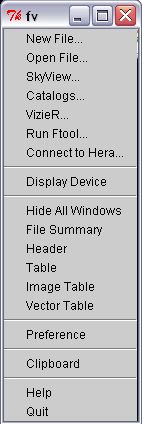|
Next: Header and Data Units Up: No Title Previous: Installation Starting fv and opening a fileThere are two modes to start a fv session: via command line, or desktop icons. On regular Linux machine, enter `fv' in a command window, after command line prompt. For Mac OS X and Windows, as of fv version 5.1, double click the 'fv' icon that is created by the installation procedure.
For the command line starting option, you can optionally append the name of a FITS file,
or multiple files, to be opened. For example, `fv ngc1316o.fit' opens a single
file, and `fv ngc*' opens all the FITS files in the current directory whose name
matches the string. Under Microsoft Windows OS and Mac OS X machine, you can start fv either
by double clicking on the fv desktop icon, or by dragging a FITS file from, say, Windows
Explorer onto the fv icon. It is also possible to set up your Windows or Unix environment
so that you can just double click (in the File Manager or on an e-mail attachment) on a
FITS file that has a standard extension like `.fit' or `.fits' and then have fv
automatically start up and open that file.
Assuming you did not specify a particular FITS file to open, fv will start by displaying a standard file browser window (Figure 1) from which you can choose which FITS file to open. Now open the file `sample.image.fits' that is included in the 'samples_data' subdirectory below the top fv software installation directory. To navigate to another directory with the browser use the button at the upper right of the window to move up a directory level and double click on a subdirectory name to move down a level. Then double click on the file name or type the name into the entry box. (After entering a few characters you can hit the Tab key to have fv automatically complete the file name). Note that if the check box at the bottom of the window is selected than fv will only list the valid FITS files in the directory (it will also display any subdirectory names). It should also be mentioned in passing that the `FTP' button in the upper right lets you connect to other machines on the internet and remotely view other available FITS files. (For example, the fits.cv.nrao.edu ftp site contains many different sample FITS files in the fits/data/samples subdirectory). After opening the sample.image.fit file (which contains an optical image of the galaxy NGC 1316) you should have 2 fv windows open on your desktop: a Desktop Manager window and a Summary window. The Desktop Manager (Figure 2) provides controls for opening files, creating new files, or exiting from fv, as well as for managing the sometimes numerous windows created by fv.
The Summary window (Figure 3) provides a capsule summary of the type and size of each major component in the file. These components are called Header-Data Units (HDUs) or `extensions' in FITS terminology. Every FITS file must have at least 1 HDU, and this first HDU is called the Primary Array. The primary array can only contain an N-dimensional array of data (typically a 2-dimensional image), but any HDUs following the primary array may each contain either an image or a table. The file we just opened only contains the primary array, but later on we will view a file that also contains a table HDU.
Next: Header and Data Units Up: No Title Previous: Installation Project Scientist: William Pence Project Engineer : Pan Chai July 2008 |




